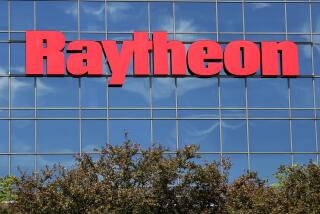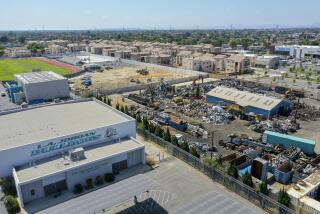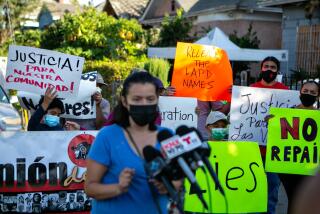Firm Agrees to Record Fine in Fatal Blast
- Share via
SIMI VALLEY — In a plea bargain worked out with federal prosecutors, Rockwell International has agreed to plead guilty to three federal felony counts and pay an unprecedented $6.5-million fine in connection with a 1994 chemical explosion that killed two scientists at the firm’s Santa Susana Field Laboratory in Ventura County.
U.S. Atty. Nora Manella commended Rockwell officials at a morning news conference Monday at her Los Angeles office for accepting responsibility in the July 26, 1994, blast that killed physicists Otto K. Heiney and Larry A. Pugh.
Two hours later, Rockwell Chief Executive Officer Don Beall called a separate news conference at the firm’s Rocketdyne division headquarters in Canoga Park in the San Fernando Valley. There, Beall admitted that the deaths of Pugh and Heiney were “a corporate failure for which we accept responsibility.”
Beall and Rocketdyne President Paul Smith denied Monday that they had any knowledge of the illegal disposal before it was exposed by a 21-month state and federal investigation into the blast.
But although the company had maintained for months that Heiney and Pugh died while conducting legitimate experiments with explosive chemicals, Smith admitted Monday that the blast came as the two were illegally burning a volatile explosive to get rid of it.
Under terms of the agreement, Rocketdyne officials were to have pleaded guilty Monday in U.S. District Court to two counts of illegal disposal of hazardous waste and one count of illegal storage of hazardous waste.
But U.S. District Judge Mariana R. Pfaelzer delayed a decision on whether to accept the plea and impose the sentence until 1:30 p.m. Thursday, saying she needed more time to review court documents.
Noting that she had read the case documents only once, Pfaelzer said, “It’s not something I fully understand.”
At the earlier news conference, referring to the agreement by Rocketdyne officials to write the U.S. government a check for $6.5 million, Manella called the sum “the largest fine ever assessed in a hazardous-waste case in the state of California.”
She told reporters: “This is not a case where the law failed us. There are laws on the books, and had they been observed, these two scientists would be alive today.”
But one environmentalist called it “like a slap on the wrist” for a company earning billions a year in defense contracts that allowed two of its employees to be killed.
“It looks like, once again, the government has caved when it comes to enforcing the laws where big corporations are involved,” said Dan Hirsch, president of a Los Angeles-based environmental watchdog group called Committee to Bridge the Gap.
As part of the agreement, Rockwell officials have promised to help U.S. prosecutors and a federal grand jury investigate possible criminal charges against the still-unidentified Rockwell employees who approved the illegal burning.
For one thing, the company agreed to finally turn over its own internal investigative records of the explosion, which the FBI subpoenaed in July 1995.
In exchange for that agreement and the promise of a guilty plea, the U.S. attorney’s office granted Rocketdyne limited immunity.
Prosecutors agreed not to charge the firm for any other crimes committed before the agreement is ratified in court that would involve illegal disposal, illegal handling, workplace safety or contract fraud related to hazardous waste.
Rockwell is also working closely with the U.S. Department of Defense to avoid any debarment or limitations on its lucrative federal aerospace and electronics contracts with the government, Smith said.
But while Assistant U.S. Atty. William Carter said he would not make any recommendations to defense investigators on Rocketdyne’s contract status, the agreement also makes no guarantees to protect that status.
And the plea agreement hints that the investigation will focus not only on Rocketdyne workers’ roles in the blast and illegal disposal, but also on the activities of UXB, the Maryland-based firm hired to clean up the volatile explosives at the field lab in the months after the fatal blast.
Heiney, 53, and Pugh, 51, worked for Rocketdyne’s chemical technology department, which researched gun propellants and flares designed to decoy heat-seeking missiles away from military targets.
The men spent much of their workweek at the field lab, a large complex of test stands and laboratory buildings that sprawls across 2,700 acres of rocky land atop the Santa Susana Mountains, between Northridge and Simi Valley.
On July 21 and July 26, 1994, Rocketdyne admits, the two physicists were disposing of triaminoguanidine nitrate, or TAGN, a highly volatile chemical used in gun propellants.
Heiney, Pugh and three other Rocketdyne employees had already burned off one batch. They had spread some of the chemical in a metal tray atop layers of sawdust, nitrocellulose and glycidal azide polymer and a device called an “electric match,” then retreated to a blockhouse to ignite it.
One of the five workers apparently returned to the still-hot test pans with a container of TAGN, which blew up in the men’s faces, instantly killing Pugh and Heiney and burning test engineer Lee Wells, who was 10 to 15 feet away.
Times staff writers Mary F. Pols and John O’Dell and correspondent Michael Krikorian contributed to this report.
More to Read
Sign up for Essential California
The most important California stories and recommendations in your inbox every morning.
You may occasionally receive promotional content from the Los Angeles Times.













